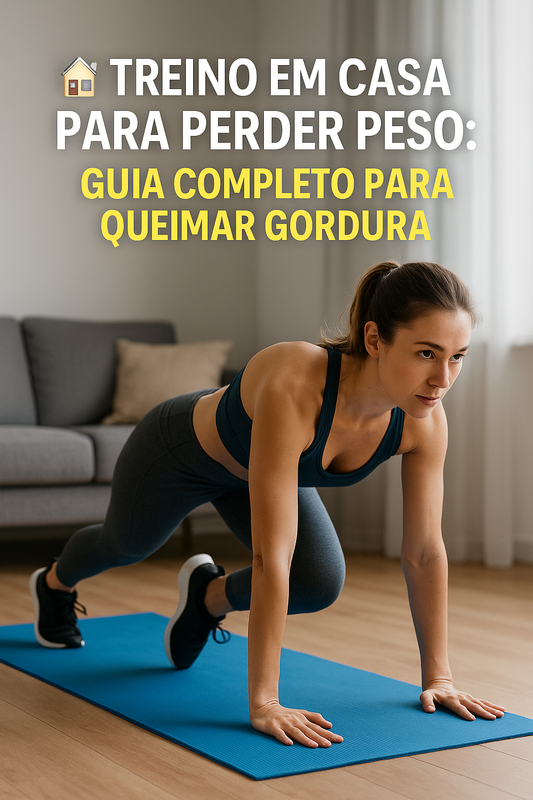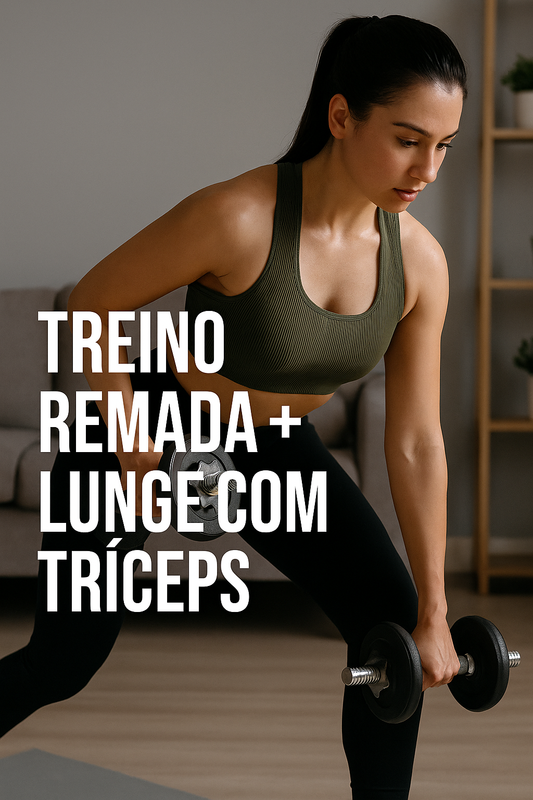
8 dumbbell exercises to do at home
Share
It is not mandatory to go to a gym to shape your body and achieve the physical appearance you have always wanted. If you like training, but the gym is not your favorite place, in this article you will find the best exercises with dumbbells, which you can do without leaving home and with visible results in terms of gaining muscle mass and toning.
Here are 8 exercises that you can perform with just dumbbells and without leaving the comfort of your home. We emphasize that the order of presentation of this Top is not indicative of the degree of importance of the exercises.
8 exercises with dumbbells to do at home
1. Squat or Squat
It is the most effective compound leg exercise you can do, as, when performed correctly, it activates a large number of muscle fibers in the quadriceps, biceps femoris and glutes.
Not only is it an exercise that allows substantial gains in muscle mass, due to the fact that it recruits a high number of muscle fibers, but it is also an exercise that can be performed with just body weight, or with an external weight, to achieve the desired effect. .
Execution:
Start by choosing whether you are going to use one or two dumbbells, depending on the degree of difficulty you want to perform the exercise. If you choose to use just one dumbbell, you must hold it with both hands and at chest height. If you use two dumbbells, simply hold them one in each hand with your arms straight at your sides.
- Place your feet shoulder-width apart or slightly further apart;
- Contract your abdominals and slowly descend, projecting your hips backwards and downwards, until your knees make an angle equal to 90 degrees (up to the parallel line);
- Make sure that your knees do not go beyond the tip of your toes, so as not to lose the posture of your lower back and unnecessarily overload the knee joint;
- Hold this position for 1 or 2 seconds and begin to rise in a controlled manner until you return to the starting position.
If you follow these instructions, you will ensure that you perform the exercise with perfect technique.
2. Triceps Push-Ups or Triceps Push-Ups
It is a very effective exercise for developing strength and muscle mass in the triceps, as it recruits the 3 portions of this muscle and allows isolated work on this region of the arm.
Execution:
- Place the dumbbells on the floor, more or less shoulder-width apart (to recruit the triceps and not the pectoral muscles) and in line with the nipples, holding the handle with your hands;
- Get into a plank position, with just your feet flat on the floor and shoulder-width apart, so that the position is stable and comfortable; ensure that your body forms a straight line between your feet and head, contracting your glutes and abdominals;
- The head should be turned slightly forward and not downwards, so that it remains in alignment with the spine;
- In this starting position, your arms must be fully extended and perfectly locked (elbows pointing backwards) to support your entire body weight;
- Begin to flex your arms, slowly and continuously, until your elbows make an angle of 90 degrees or less; always keep your arms close to your torso and don't lose muscle tension, so that your body always remains in a plank position;
- As soon as your chest touches the dumbbells, pause briefly in this position and then explode, pushing the dumbbells with your hands, to return to the starting position, with your arms fully extended, and be able to start the next repetition.
In this exercise, cadence is very important. The descent should be done in about 3 seconds and, after pausing for 1 second at the bottom, you should explode on the way up, in order to also recruit the fast-acting muscle fibers and achieve effective hypertrophy of the three portions of this muscle.
3. French Triceps
This exercise serves as a complement to the previous exercise. It allows you to place more emphasis on the long portion of the triceps, recruiting this specific region in isolation.
Execution:
- Get a stable bench or chair, so that you can perform the exercise more correctly;
- Place the dumbbell above your head, holding it with both hands, and always keeping your lumbar spine straight and your arms in full extension;
- With your elbows locked next to your head and pointing forward, start and lower the dumbbell until it touches the upper part of your back, or until you feel a complete stretch in your triceps;
- Then return the dumbbell to the starting position, always keeping your elbows still and in the same position.
In this exercise, it is important to keep your elbows pointed forward and always static, to ensure that you recruit the long portion of the triceps, which is the main objective of this exercise.
4. Side Openings or Side Raises
It is an excellent exercise for the shoulder muscles, responsible for abduction. It is this type of exercise that allows you to gain muscle mass and volume in the lateral portion of the shoulder, which contributes to that much desired “V” appearance.
Execution:
To perform this exercise, simply use two dumbbells with little weight, as the shoulders are made up of small muscles and adding extra weight to this type of isolated exercise increases the risk of injury.
- Sit on a chair or stable bench, hold a dumbbell in each hand and lean your torso forward, towards your thighs, always maintaining the curvature of your lower back;
- Position the dumbbells next to the body, without the arms being fully stretched;
- Simultaneously begin the lateral elevation of the arms to shoulder height, followed by the controlled lowering of the dumbbells to the starting position.
You should not use any type of push or swing, as the objective is to place the shoulder under as much tension as possible, for as long as possible, in order to achieve the contraction necessary for muscular hypertrophy.
5. Shoulder Press
This exercise is the equivalent of the overhead press compound exercise, but with the use of dumbbells. It is a very important exercise for developing shoulder muscles, as it recruits a large number of muscle fibers, which results in gains in muscle mass in this area.
Execution:
This exercise can be performed sitting or standing, with the body in full extension. The important thing is that your back is always aligned, maintaining its neutral curvature, and your abdominals contracted to ensure good stability.
- Hold a dumbbell in each hand and place them on your shoulders;
- Tightens the core, activates the shoulder muscles and, without any impulse, raises the weights directly above the head, simultaneously;
- The movement ends with the dumbbells in an overhead position, with the arms completely stretched and positioned next to the ears, with the shoulders and elbows locked;
- Do the reverse movement to place the dumbbells back at shoulder level.
6. Biceps Curl
It's a simple but very effective biceps exercise. Although it is simple, this exercise is included in all training plans that aim to increase muscle mass in the arm. In this exercise, as in all others, good execution always means being able to recruit the muscle we want to develop.
Execution:
In this exercise, and once again, the lower back must always be straight, maintaining a neutral curvature. It seems repetitive, but it is very important to prevent injuries.
- Standing in a fully extended position, hold a dumbbell in each hand, with your arms stretched out at your sides and your palms facing inward;
- Contract your core, activate the muscles in the anterior region of your arm and, at the same time, start lifting the dumbbells without any impulse, until you reach the maximum point of contraction of your biceps; as you bend your arms, rotate your palms to the supinated position;
- Keep your elbows locked and static at your sides;
- After maximum contraction, lower the weights in a controlled manner, in the negative or eccentric phase, until you return to the starting position.
The negative or eccentric phase is a phase of the movement (corresponding to the extension of the muscles) that is easily overlooked, although it is scientifically proven that it is in this phase that we recruit a greater number of muscle fibers, which is equivalent to greater hypertrophy and greater strength gains. .
A good way to ensure that you are performing this exercise correctly and productively is to count three seconds on the way up and three seconds on the way down. Here, once again, it is really important to be able to work the muscle in isolation and not the loads used. Therefore, perform this exercise with an accessible weight to achieve the best results.
7. Hammer Curl
The big difference between this exercise and the Biceps Curl lies in the fact that the grip is changed: instead of finishing the movement with a supinated grip, the palms of the hands always remain facing inwards (neutral or “hammer” grip), which allows you to activate the brachial part of the biceps more easily.
Execution:
The execution is exactly the same as the previous exercise, and, as already mentioned, the grip, instead of being supinated, is neutral, that is, instead of finishing with the dumbbells facing you with the palm of your hand facing behind, the movement begins and ends with the palm always facing inwards.
8. Front Lunges or Front Lunges
This is a complementary exercise to the squat, which places greater emphasis on the glutes and femoral biceps, allowing these muscles to be recruited more and not so much the quadriceps, as happens in conventional squats.
This way, we can work our legs in a harmonious way, not leaving some muscle groups more developed, to the detriment of others, which could be detrimental in terms of symmetry.
Execution:
- Standing, with your body in full extension and neutral lumbar curvature, hold a dumbbell in each hand, with your arms straight at your sides;
- Activate your core and glutes and take a step forward, moving your right foot forward and bending your legs until the knee of your back leg (left leg) touches the floor; ensures that both legs are bent at 90 degrees;
- Always keep your torso straight, not letting yourself lean forward, and make sure that the knee of your front leg does not go beyond the tip of your foot;
- In this position, press your right heel against the floor and go up until both legs are straight again;
- Move your right leg back to return to the starting position;
- Repeat the movement, now moving forward with your left leg.
This exercise can be performed statically (without leaving your seat) or in movement (walking lunge), although performing the latter requires some space but you have fun walking around the house while working your legs.



